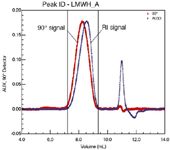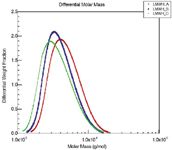Light Scattering for the Masses Heparin Characterization
Wyatt Technology Application Note
Wyatt Technology Corp., Santa Barbara, California, USA.
Heparin is well-known as an anti-coagulant, anti-thrombotic drug. Chemically, it is a linear polysaccharide that is derived from animal tissues. For some time it has been known that heparin is not a homogeneous substance; rather, it is a heterogeneous mixture of molecules ranging in molar mass from less than 5000 to more than 30000 Daltons. Heparin can be chemically or enzymatically depolymerized to obtain low molecular weight (LMW) heparin products, which exhibit an improved pharmacological profile.
The US Food and Drug Administration (FDA) has scrutinized LMW-heparin products closely due to their inherent variability and polydispersity. Previously, these materials had to be characterized by relative techniques involving viscometry or standard elution-based chromatographic methods. Fortunately, the advent of multiangle laser light scattering combined with SEC means that authentic calibration standards derived from heparin are no longer necessary. LMW-heparins may now be characterized absolutely — without regard for the molecules' elution time or conformation in solution.

Figure 1: One of the three samples displayed by ASTRA. Note the different response of the miniDAWN and the RI detector at the same elution volumes.
For this application note, Scientific Protein Laboratories (Waunakee, Wisconsin, USA), a subsidiary of American Home Products Corporation, analysed three commercial LMW heparin products. They employed a Waters 510 pump and 401 refractometer, a Shodex OHpak SB-803HQ analytical column (8.0 × 300 mm) with an SB-G guard column and a miniDAWN, triple angle light scattering instrument. The mobile phase was 0.1 M ammonium acetate, and the specific refractive index increment, dn/dc was measured off-line in a Wyatt/Optilab DSP operating at the same wavelength as the miniDAWN. Details of this study were published in Analytical Biochemistry 245, 231–241 (1997).
The results show unequivocally the power of the miniDAWN to resolve the three LMW-heparin products, each of which was manufactured by a different depolymerization process. Wyatt Technology's ASTRA software indicates that clear differences exits in these products' differential molar mass distributions (Figure 2).

Figure 2: The differential molar mass distributions tell the entire story: the three samples are different! An indication of different derivitization processes.
We sincerely thank James Knobloch and Dr. Patrick Shaklee, Scientific Protein Labs, for sharing these data with us and permitting us to publish their results.

Wyatt Technology Corporation
6300 Hollister Avenue, Santa Barbara California 93117, USA
tel. +1 805 681 9009 fax +1 805 681 0123
E-mail: info@wyatt.com
Website: www.wyatt.com

Separating Impurities from Oligonucleotides Using Supercritical Fluid Chromatography
February 21st 2025Supercritical fluid chromatography (SFC) has been optimized for the analysis of 5-, 10-, 15-, and 18-mer oligonucleotides (ONs) and evaluated for its effectiveness in separating impurities from ONs.



















